A Study on How Physical Activity Affects Intelligence and Attitude
VerifiedAdded on 2023/06/05
|11
|2926
|52
Report
AI Summary
This research investigates the influence of physical activity on intelligence and attitude among high school students. A sample of 100 students participated in light, moderate, and vigorous physical activities, and their intelligence quotient (IQ) was measured using the Wechsler scale (WAIS-IV). The study employs a One-Way Multivariate Analysis of Variance (MANOVA) to determine the association between physical activity (independent variable) and intelligence and attitude (dependent variables). The research aims to determine if physical activities influence intelligence and attitude, testing hypotheses related to the positive and significant relationship between these variables. Data was collected through questionnaires and IQ tests, analyzed using SPSS, and the findings are discussed in relation to existing literature on the benefits of physical fitness and its impact on cognitive performance and attitude.
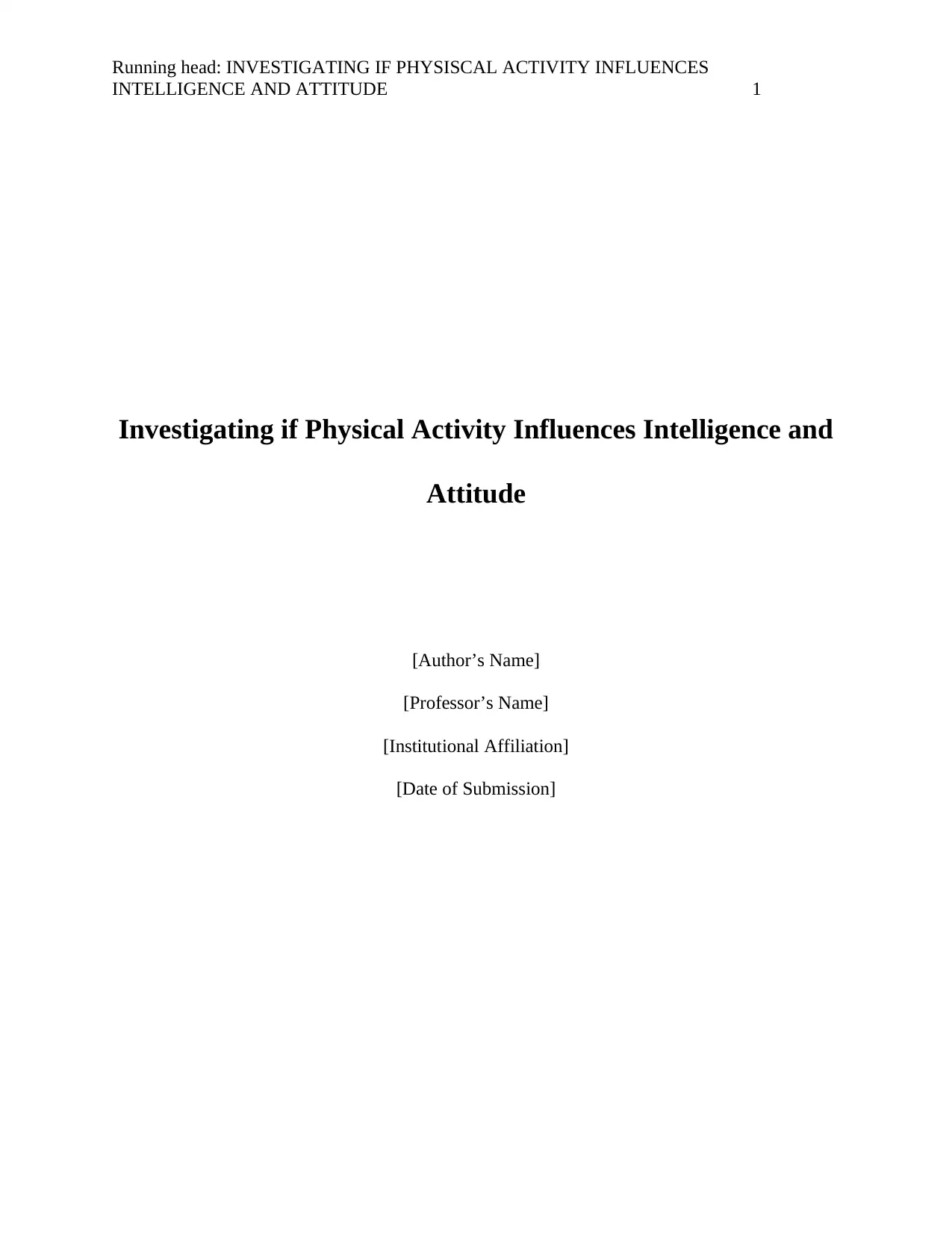
Running head: INVESTIGATING IF PHYSISCAL ACTIVITY INFLUENCES
INTELLIGENCE AND ATTITUDE 1
Investigating if Physical Activity Influences Intelligence and
Attitude
[Author’s Name]
[Professor’s Name]
[Institutional Affiliation]
[Date of Submission]
INTELLIGENCE AND ATTITUDE 1
Investigating if Physical Activity Influences Intelligence and
Attitude
[Author’s Name]
[Professor’s Name]
[Institutional Affiliation]
[Date of Submission]
Paraphrase This Document
Need a fresh take? Get an instant paraphrase of this document with our AI Paraphraser
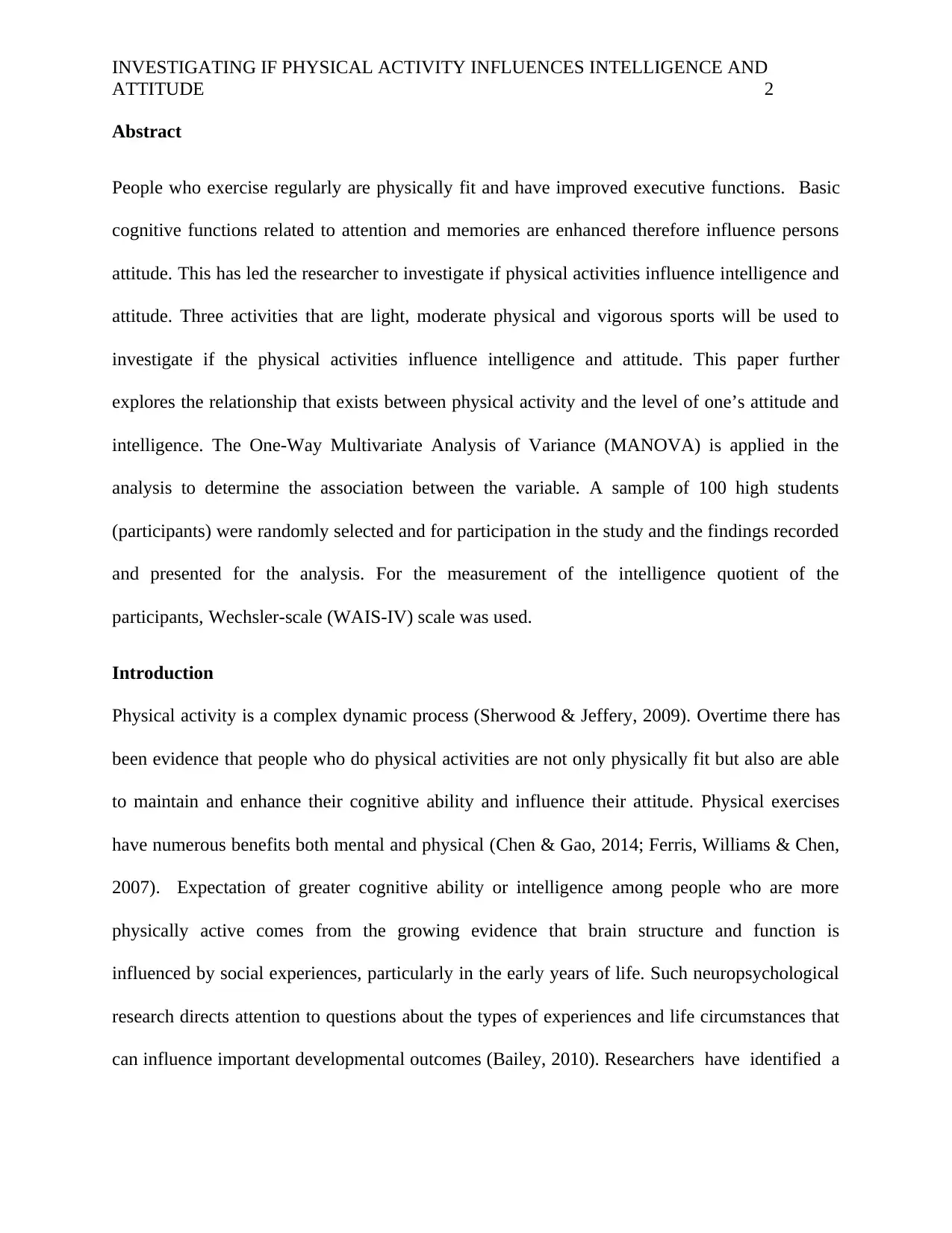
INVESTIGATING IF PHYSICAL ACTIVITY INFLUENCES INTELLIGENCE AND
ATTITUDE 2
Abstract
People who exercise regularly are physically fit and have improved executive functions. Basic
cognitive functions related to attention and memories are enhanced therefore influence persons
attitude. This has led the researcher to investigate if physical activities influence intelligence and
attitude. Three activities that are light, moderate physical and vigorous sports will be used to
investigate if the physical activities influence intelligence and attitude. This paper further
explores the relationship that exists between physical activity and the level of one’s attitude and
intelligence. The One-Way Multivariate Analysis of Variance (MANOVA) is applied in the
analysis to determine the association between the variable. A sample of 100 high students
(participants) were randomly selected and for participation in the study and the findings recorded
and presented for the analysis. For the measurement of the intelligence quotient of the
participants, Wechsler-scale (WAIS-IV) scale was used.
Introduction
Physical activity is a complex dynamic process (Sherwood & Jeffery, 2009). Overtime there has
been evidence that people who do physical activities are not only physically fit but also are able
to maintain and enhance their cognitive ability and influence their attitude. Physical exercises
have numerous benefits both mental and physical (Chen & Gao, 2014; Ferris, Williams & Chen,
2007). Expectation of greater cognitive ability or intelligence among people who are more
physically active comes from the growing evidence that brain structure and function is
influenced by social experiences, particularly in the early years of life. Such neuropsychological
research directs attention to questions about the types of experiences and life circumstances that
can influence important developmental outcomes (Bailey, 2010). Researchers have identified a
ATTITUDE 2
Abstract
People who exercise regularly are physically fit and have improved executive functions. Basic
cognitive functions related to attention and memories are enhanced therefore influence persons
attitude. This has led the researcher to investigate if physical activities influence intelligence and
attitude. Three activities that are light, moderate physical and vigorous sports will be used to
investigate if the physical activities influence intelligence and attitude. This paper further
explores the relationship that exists between physical activity and the level of one’s attitude and
intelligence. The One-Way Multivariate Analysis of Variance (MANOVA) is applied in the
analysis to determine the association between the variable. A sample of 100 high students
(participants) were randomly selected and for participation in the study and the findings recorded
and presented for the analysis. For the measurement of the intelligence quotient of the
participants, Wechsler-scale (WAIS-IV) scale was used.
Introduction
Physical activity is a complex dynamic process (Sherwood & Jeffery, 2009). Overtime there has
been evidence that people who do physical activities are not only physically fit but also are able
to maintain and enhance their cognitive ability and influence their attitude. Physical exercises
have numerous benefits both mental and physical (Chen & Gao, 2014; Ferris, Williams & Chen,
2007). Expectation of greater cognitive ability or intelligence among people who are more
physically active comes from the growing evidence that brain structure and function is
influenced by social experiences, particularly in the early years of life. Such neuropsychological
research directs attention to questions about the types of experiences and life circumstances that
can influence important developmental outcomes (Bailey, 2010). Researchers have identified a

INVESTIGATING IF PHYSICAL ACTIVITY INFLUENCES INTELLIGENCE AND
ATTITUDE 3
likely mechanism for linkages between physical activity and intelligence (Bruton & Robles,
2009).
Executive function which is intelligence is a set of mental skills which depends on higher-order
cognitive processes that supports sustained attention, planning, resistance to interference,
selective attention, working memory, volitional inhibition and mental flexibility (Chan, Bass,
Guimaraes, & Chen, 2014). These functions are highly important for the survival of humans and
the functions mostly depends on the frontal lobes, temporal and parietal cortices. (Miyake et al.,
2000). Not only do physical activities improve memory and teach (Robinson & Fraser, 2012), it
also results in a robust long-term memory benefit (Bruton & Robles, 2009; Gan & Cothran,
2016).
Individuals are engaged in physical activity for both intrinsic and extrinsic reasons (Fraser, K.R.,
Robinson, J.M., Guimaraes, E., Fraser, A., Ciolac, K.K., & Bishop, M, 2015). The most common
intrinsic reasons to participate in physical activity are enjoyment, challenge, and skill
development, whereas the common extrinsic reasons to participate in physical activity are
socialization, maintaining an attractive appearance, and gaining a good reputation (Coe, D. P., &
Perterson, T., & Blair, 2008), these influence individual attitudes as they have an element of
individuals participation without reservation.
Physical Activity, Intelligence and Attitude
In regard to physical activity, an active lifestyle has considerable importance for the well-being
and health among human beings. Many studies related to physical activity across the lifespan of
human beings is related with little evidences of the chronic conditions (Bass, 2012). It is
therefore not surprising that many researchers are targeting the identification of factors that are
ATTITUDE 3
likely mechanism for linkages between physical activity and intelligence (Bruton & Robles,
2009).
Executive function which is intelligence is a set of mental skills which depends on higher-order
cognitive processes that supports sustained attention, planning, resistance to interference,
selective attention, working memory, volitional inhibition and mental flexibility (Chan, Bass,
Guimaraes, & Chen, 2014). These functions are highly important for the survival of humans and
the functions mostly depends on the frontal lobes, temporal and parietal cortices. (Miyake et al.,
2000). Not only do physical activities improve memory and teach (Robinson & Fraser, 2012), it
also results in a robust long-term memory benefit (Bruton & Robles, 2009; Gan & Cothran,
2016).
Individuals are engaged in physical activity for both intrinsic and extrinsic reasons (Fraser, K.R.,
Robinson, J.M., Guimaraes, E., Fraser, A., Ciolac, K.K., & Bishop, M, 2015). The most common
intrinsic reasons to participate in physical activity are enjoyment, challenge, and skill
development, whereas the common extrinsic reasons to participate in physical activity are
socialization, maintaining an attractive appearance, and gaining a good reputation (Coe, D. P., &
Perterson, T., & Blair, 2008), these influence individual attitudes as they have an element of
individuals participation without reservation.
Physical Activity, Intelligence and Attitude
In regard to physical activity, an active lifestyle has considerable importance for the well-being
and health among human beings. Many studies related to physical activity across the lifespan of
human beings is related with little evidences of the chronic conditions (Bass, 2012). It is
therefore not surprising that many researchers are targeting the identification of factors that are
⊘ This is a preview!⊘
Do you want full access?
Subscribe today to unlock all pages.

Trusted by 1+ million students worldwide
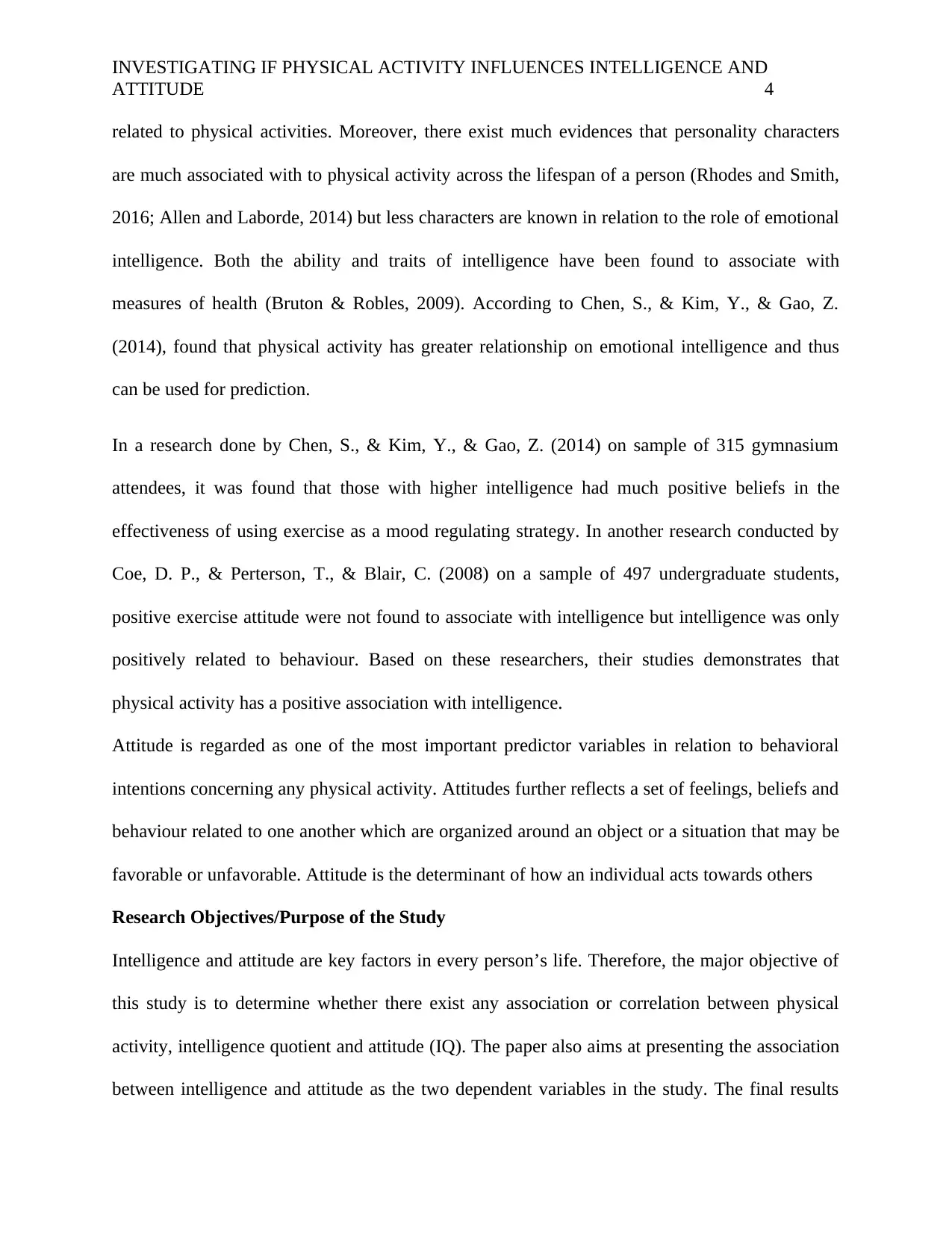
INVESTIGATING IF PHYSICAL ACTIVITY INFLUENCES INTELLIGENCE AND
ATTITUDE 4
related to physical activities. Moreover, there exist much evidences that personality characters
are much associated with to physical activity across the lifespan of a person (Rhodes and Smith,
2016; Allen and Laborde, 2014) but less characters are known in relation to the role of emotional
intelligence. Both the ability and traits of intelligence have been found to associate with
measures of health (Bruton & Robles, 2009). According to Chen, S., & Kim, Y., & Gao, Z.
(2014), found that physical activity has greater relationship on emotional intelligence and thus
can be used for prediction.
In a research done by Chen, S., & Kim, Y., & Gao, Z. (2014) on sample of 315 gymnasium
attendees, it was found that those with higher intelligence had much positive beliefs in the
effectiveness of using exercise as a mood regulating strategy. In another research conducted by
Coe, D. P., & Perterson, T., & Blair, C. (2008) on a sample of 497 undergraduate students,
positive exercise attitude were not found to associate with intelligence but intelligence was only
positively related to behaviour. Based on these researchers, their studies demonstrates that
physical activity has a positive association with intelligence.
Attitude is regarded as one of the most important predictor variables in relation to behavioral
intentions concerning any physical activity. Attitudes further reflects a set of feelings, beliefs and
behaviour related to one another which are organized around an object or a situation that may be
favorable or unfavorable. Attitude is the determinant of how an individual acts towards others
Research Objectives/Purpose of the Study
Intelligence and attitude are key factors in every person’s life. Therefore, the major objective of
this study is to determine whether there exist any association or correlation between physical
activity, intelligence quotient and attitude (IQ). The paper also aims at presenting the association
between intelligence and attitude as the two dependent variables in the study. The final results
ATTITUDE 4
related to physical activities. Moreover, there exist much evidences that personality characters
are much associated with to physical activity across the lifespan of a person (Rhodes and Smith,
2016; Allen and Laborde, 2014) but less characters are known in relation to the role of emotional
intelligence. Both the ability and traits of intelligence have been found to associate with
measures of health (Bruton & Robles, 2009). According to Chen, S., & Kim, Y., & Gao, Z.
(2014), found that physical activity has greater relationship on emotional intelligence and thus
can be used for prediction.
In a research done by Chen, S., & Kim, Y., & Gao, Z. (2014) on sample of 315 gymnasium
attendees, it was found that those with higher intelligence had much positive beliefs in the
effectiveness of using exercise as a mood regulating strategy. In another research conducted by
Coe, D. P., & Perterson, T., & Blair, C. (2008) on a sample of 497 undergraduate students,
positive exercise attitude were not found to associate with intelligence but intelligence was only
positively related to behaviour. Based on these researchers, their studies demonstrates that
physical activity has a positive association with intelligence.
Attitude is regarded as one of the most important predictor variables in relation to behavioral
intentions concerning any physical activity. Attitudes further reflects a set of feelings, beliefs and
behaviour related to one another which are organized around an object or a situation that may be
favorable or unfavorable. Attitude is the determinant of how an individual acts towards others
Research Objectives/Purpose of the Study
Intelligence and attitude are key factors in every person’s life. Therefore, the major objective of
this study is to determine whether there exist any association or correlation between physical
activity, intelligence quotient and attitude (IQ). The paper also aims at presenting the association
between intelligence and attitude as the two dependent variables in the study. The final results
Paraphrase This Document
Need a fresh take? Get an instant paraphrase of this document with our AI Paraphraser
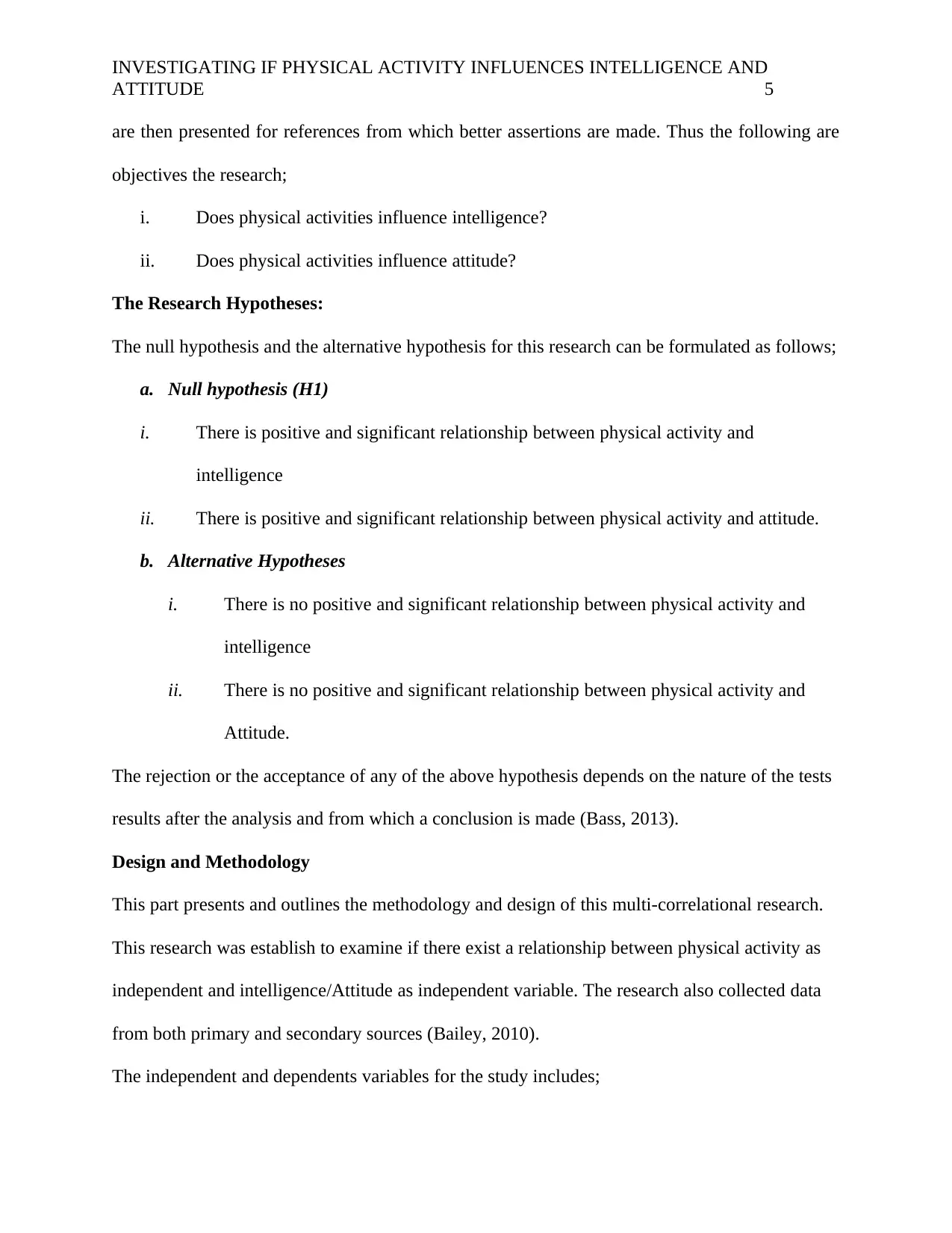
INVESTIGATING IF PHYSICAL ACTIVITY INFLUENCES INTELLIGENCE AND
ATTITUDE 5
are then presented for references from which better assertions are made. Thus the following are
objectives the research;
i. Does physical activities influence intelligence?
ii. Does physical activities influence attitude?
The Research Hypotheses:
The null hypothesis and the alternative hypothesis for this research can be formulated as follows;
a. Null hypothesis (H1)
i. There is positive and significant relationship between physical activity and
intelligence
ii. There is positive and significant relationship between physical activity and attitude.
b. Alternative Hypotheses
i. There is no positive and significant relationship between physical activity and
intelligence
ii. There is no positive and significant relationship between physical activity and
Attitude.
The rejection or the acceptance of any of the above hypothesis depends on the nature of the tests
results after the analysis and from which a conclusion is made (Bass, 2013).
Design and Methodology
This part presents and outlines the methodology and design of this multi-correlational research.
This research was establish to examine if there exist a relationship between physical activity as
independent and intelligence/Attitude as independent variable. The research also collected data
from both primary and secondary sources (Bailey, 2010).
The independent and dependents variables for the study includes;
ATTITUDE 5
are then presented for references from which better assertions are made. Thus the following are
objectives the research;
i. Does physical activities influence intelligence?
ii. Does physical activities influence attitude?
The Research Hypotheses:
The null hypothesis and the alternative hypothesis for this research can be formulated as follows;
a. Null hypothesis (H1)
i. There is positive and significant relationship between physical activity and
intelligence
ii. There is positive and significant relationship between physical activity and attitude.
b. Alternative Hypotheses
i. There is no positive and significant relationship between physical activity and
intelligence
ii. There is no positive and significant relationship between physical activity and
Attitude.
The rejection or the acceptance of any of the above hypothesis depends on the nature of the tests
results after the analysis and from which a conclusion is made (Bass, 2013).
Design and Methodology
This part presents and outlines the methodology and design of this multi-correlational research.
This research was establish to examine if there exist a relationship between physical activity as
independent and intelligence/Attitude as independent variable. The research also collected data
from both primary and secondary sources (Bailey, 2010).
The independent and dependents variables for the study includes;
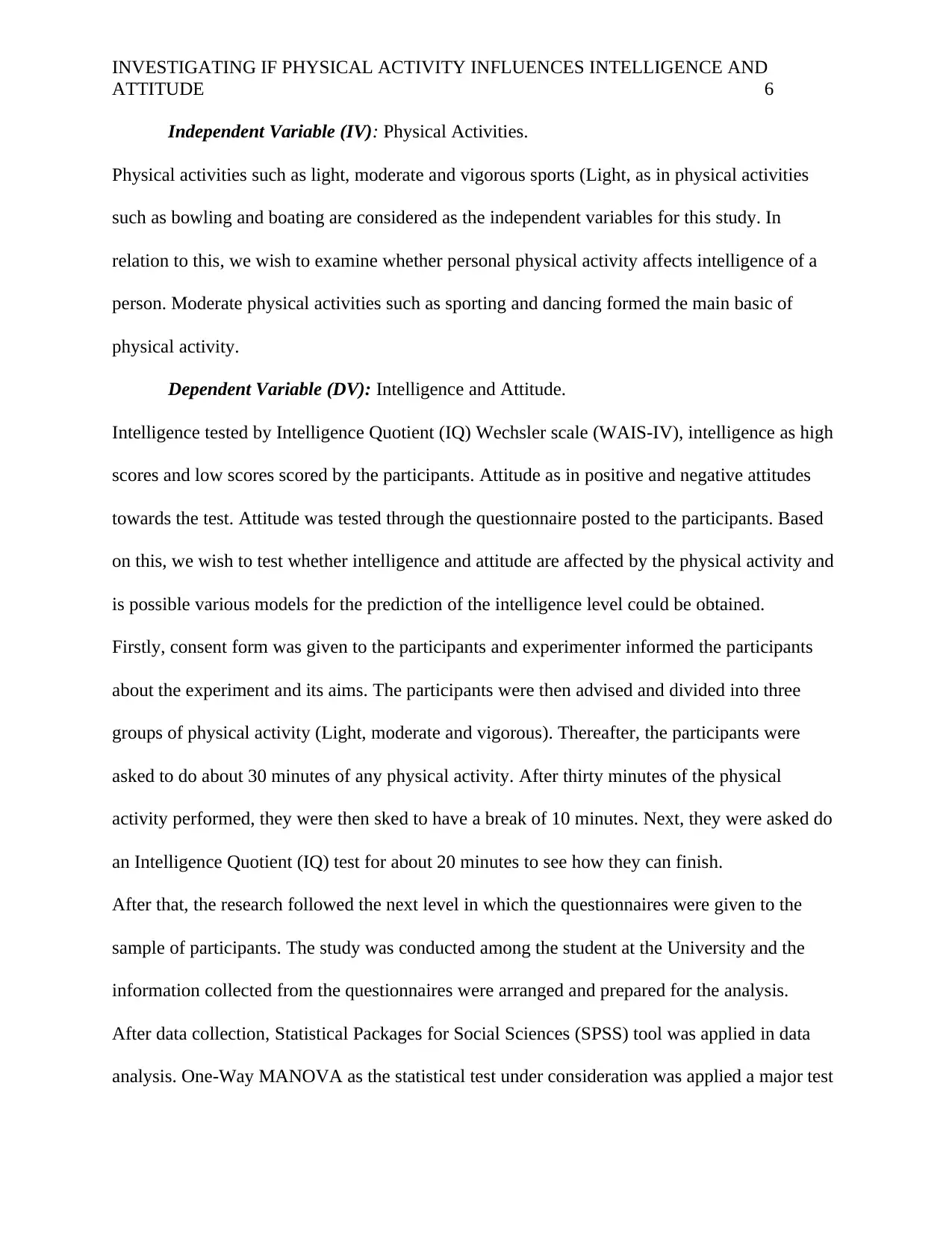
INVESTIGATING IF PHYSICAL ACTIVITY INFLUENCES INTELLIGENCE AND
ATTITUDE 6
Independent Variable (IV): Physical Activities.
Physical activities such as light, moderate and vigorous sports (Light, as in physical activities
such as bowling and boating are considered as the independent variables for this study. In
relation to this, we wish to examine whether personal physical activity affects intelligence of a
person. Moderate physical activities such as sporting and dancing formed the main basic of
physical activity.
Dependent Variable (DV): Intelligence and Attitude.
Intelligence tested by Intelligence Quotient (IQ) Wechsler scale (WAIS-IV), intelligence as high
scores and low scores scored by the participants. Attitude as in positive and negative attitudes
towards the test. Attitude was tested through the questionnaire posted to the participants. Based
on this, we wish to test whether intelligence and attitude are affected by the physical activity and
is possible various models for the prediction of the intelligence level could be obtained.
Firstly, consent form was given to the participants and experimenter informed the participants
about the experiment and its aims. The participants were then advised and divided into three
groups of physical activity (Light, moderate and vigorous). Thereafter, the participants were
asked to do about 30 minutes of any physical activity. After thirty minutes of the physical
activity performed, they were then sked to have a break of 10 minutes. Next, they were asked do
an Intelligence Quotient (IQ) test for about 20 minutes to see how they can finish.
After that, the research followed the next level in which the questionnaires were given to the
sample of participants. The study was conducted among the student at the University and the
information collected from the questionnaires were arranged and prepared for the analysis.
After data collection, Statistical Packages for Social Sciences (SPSS) tool was applied in data
analysis. One-Way MANOVA as the statistical test under consideration was applied a major test
ATTITUDE 6
Independent Variable (IV): Physical Activities.
Physical activities such as light, moderate and vigorous sports (Light, as in physical activities
such as bowling and boating are considered as the independent variables for this study. In
relation to this, we wish to examine whether personal physical activity affects intelligence of a
person. Moderate physical activities such as sporting and dancing formed the main basic of
physical activity.
Dependent Variable (DV): Intelligence and Attitude.
Intelligence tested by Intelligence Quotient (IQ) Wechsler scale (WAIS-IV), intelligence as high
scores and low scores scored by the participants. Attitude as in positive and negative attitudes
towards the test. Attitude was tested through the questionnaire posted to the participants. Based
on this, we wish to test whether intelligence and attitude are affected by the physical activity and
is possible various models for the prediction of the intelligence level could be obtained.
Firstly, consent form was given to the participants and experimenter informed the participants
about the experiment and its aims. The participants were then advised and divided into three
groups of physical activity (Light, moderate and vigorous). Thereafter, the participants were
asked to do about 30 minutes of any physical activity. After thirty minutes of the physical
activity performed, they were then sked to have a break of 10 minutes. Next, they were asked do
an Intelligence Quotient (IQ) test for about 20 minutes to see how they can finish.
After that, the research followed the next level in which the questionnaires were given to the
sample of participants. The study was conducted among the student at the University and the
information collected from the questionnaires were arranged and prepared for the analysis.
After data collection, Statistical Packages for Social Sciences (SPSS) tool was applied in data
analysis. One-Way MANOVA as the statistical test under consideration was applied a major test
⊘ This is a preview!⊘
Do you want full access?
Subscribe today to unlock all pages.

Trusted by 1+ million students worldwide
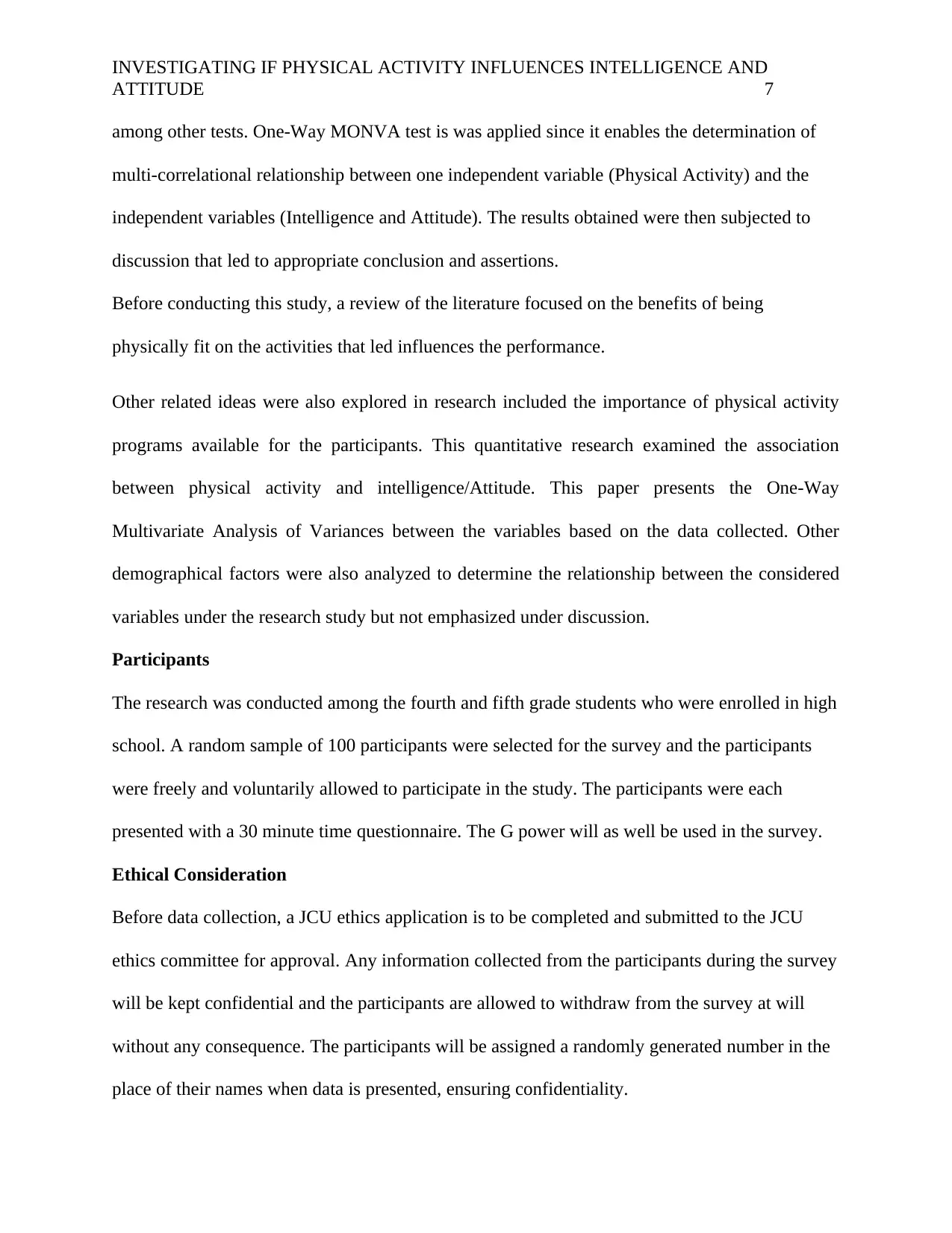
INVESTIGATING IF PHYSICAL ACTIVITY INFLUENCES INTELLIGENCE AND
ATTITUDE 7
among other tests. One-Way MONVA test is was applied since it enables the determination of
multi-correlational relationship between one independent variable (Physical Activity) and the
independent variables (Intelligence and Attitude). The results obtained were then subjected to
discussion that led to appropriate conclusion and assertions.
Before conducting this study, a review of the literature focused on the benefits of being
physically fit on the activities that led influences the performance.
Other related ideas were also explored in research included the importance of physical activity
programs available for the participants. This quantitative research examined the association
between physical activity and intelligence/Attitude. This paper presents the One-Way
Multivariate Analysis of Variances between the variables based on the data collected. Other
demographical factors were also analyzed to determine the relationship between the considered
variables under the research study but not emphasized under discussion.
Participants
The research was conducted among the fourth and fifth grade students who were enrolled in high
school. A random sample of 100 participants were selected for the survey and the participants
were freely and voluntarily allowed to participate in the study. The participants were each
presented with a 30 minute time questionnaire. The G power will as well be used in the survey.
Ethical Consideration
Before data collection, a JCU ethics application is to be completed and submitted to the JCU
ethics committee for approval. Any information collected from the participants during the survey
will be kept confidential and the participants are allowed to withdraw from the survey at will
without any consequence. The participants will be assigned a randomly generated number in the
place of their names when data is presented, ensuring confidentiality.
ATTITUDE 7
among other tests. One-Way MONVA test is was applied since it enables the determination of
multi-correlational relationship between one independent variable (Physical Activity) and the
independent variables (Intelligence and Attitude). The results obtained were then subjected to
discussion that led to appropriate conclusion and assertions.
Before conducting this study, a review of the literature focused on the benefits of being
physically fit on the activities that led influences the performance.
Other related ideas were also explored in research included the importance of physical activity
programs available for the participants. This quantitative research examined the association
between physical activity and intelligence/Attitude. This paper presents the One-Way
Multivariate Analysis of Variances between the variables based on the data collected. Other
demographical factors were also analyzed to determine the relationship between the considered
variables under the research study but not emphasized under discussion.
Participants
The research was conducted among the fourth and fifth grade students who were enrolled in high
school. A random sample of 100 participants were selected for the survey and the participants
were freely and voluntarily allowed to participate in the study. The participants were each
presented with a 30 minute time questionnaire. The G power will as well be used in the survey.
Ethical Consideration
Before data collection, a JCU ethics application is to be completed and submitted to the JCU
ethics committee for approval. Any information collected from the participants during the survey
will be kept confidential and the participants are allowed to withdraw from the survey at will
without any consequence. The participants will be assigned a randomly generated number in the
place of their names when data is presented, ensuring confidentiality.
Paraphrase This Document
Need a fresh take? Get an instant paraphrase of this document with our AI Paraphraser
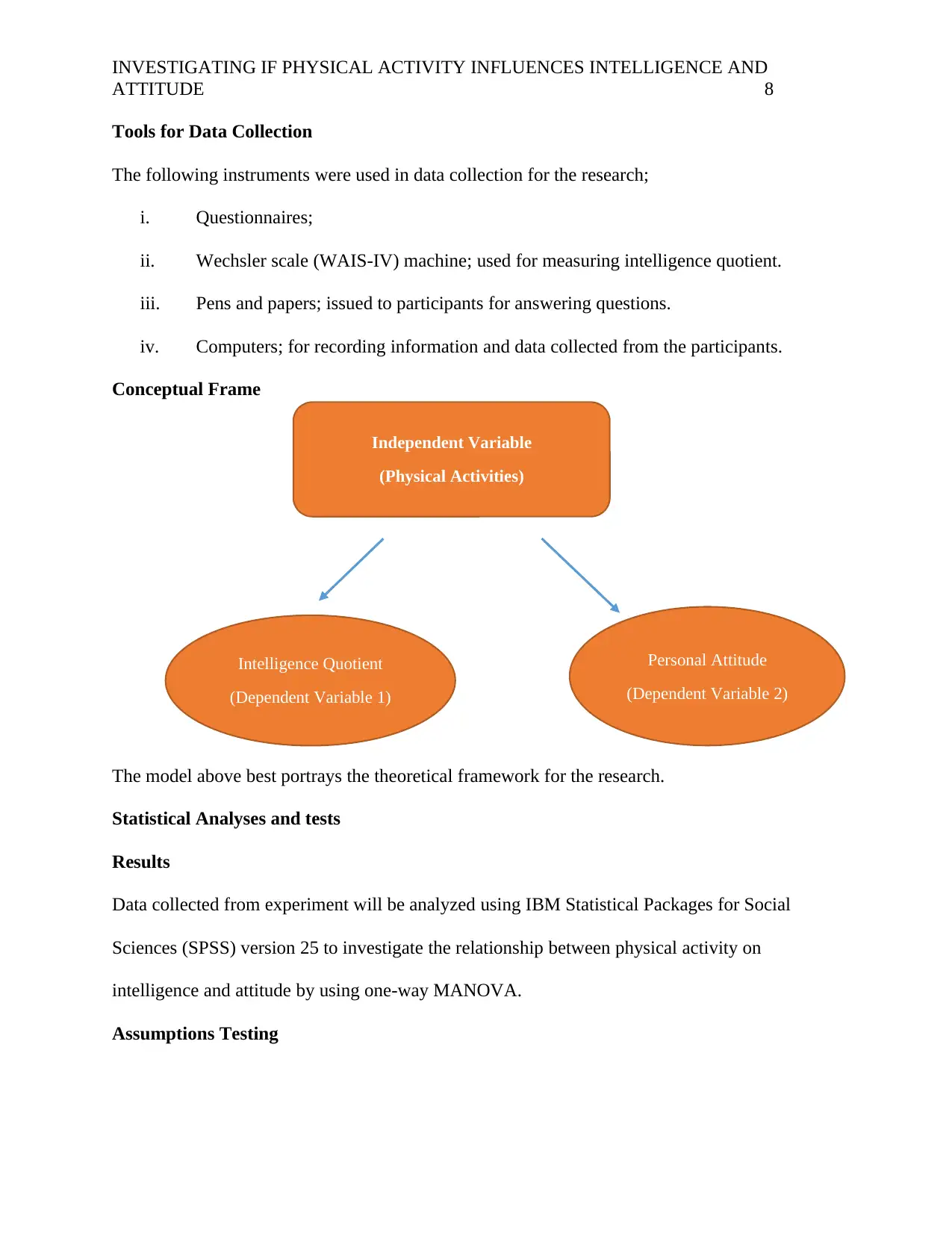
INVESTIGATING IF PHYSICAL ACTIVITY INFLUENCES INTELLIGENCE AND
ATTITUDE 8
Tools for Data Collection
The following instruments were used in data collection for the research;
i. Questionnaires;
ii. Wechsler scale (WAIS-IV) machine; used for measuring intelligence quotient.
iii. Pens and papers; issued to participants for answering questions.
iv. Computers; for recording information and data collected from the participants.
Conceptual Frame
The model above best portrays the theoretical framework for the research.
Statistical Analyses and tests
Results
Data collected from experiment will be analyzed using IBM Statistical Packages for Social
Sciences (SPSS) version 25 to investigate the relationship between physical activity on
intelligence and attitude by using one-way MANOVA.
Assumptions Testing
Independent Variable
(Physical Activities)
Intelligence Quotient
(Dependent Variable 1)
Personal Attitude
(Dependent Variable 2)
ATTITUDE 8
Tools for Data Collection
The following instruments were used in data collection for the research;
i. Questionnaires;
ii. Wechsler scale (WAIS-IV) machine; used for measuring intelligence quotient.
iii. Pens and papers; issued to participants for answering questions.
iv. Computers; for recording information and data collected from the participants.
Conceptual Frame
The model above best portrays the theoretical framework for the research.
Statistical Analyses and tests
Results
Data collected from experiment will be analyzed using IBM Statistical Packages for Social
Sciences (SPSS) version 25 to investigate the relationship between physical activity on
intelligence and attitude by using one-way MANOVA.
Assumptions Testing
Independent Variable
(Physical Activities)
Intelligence Quotient
(Dependent Variable 1)
Personal Attitude
(Dependent Variable 2)
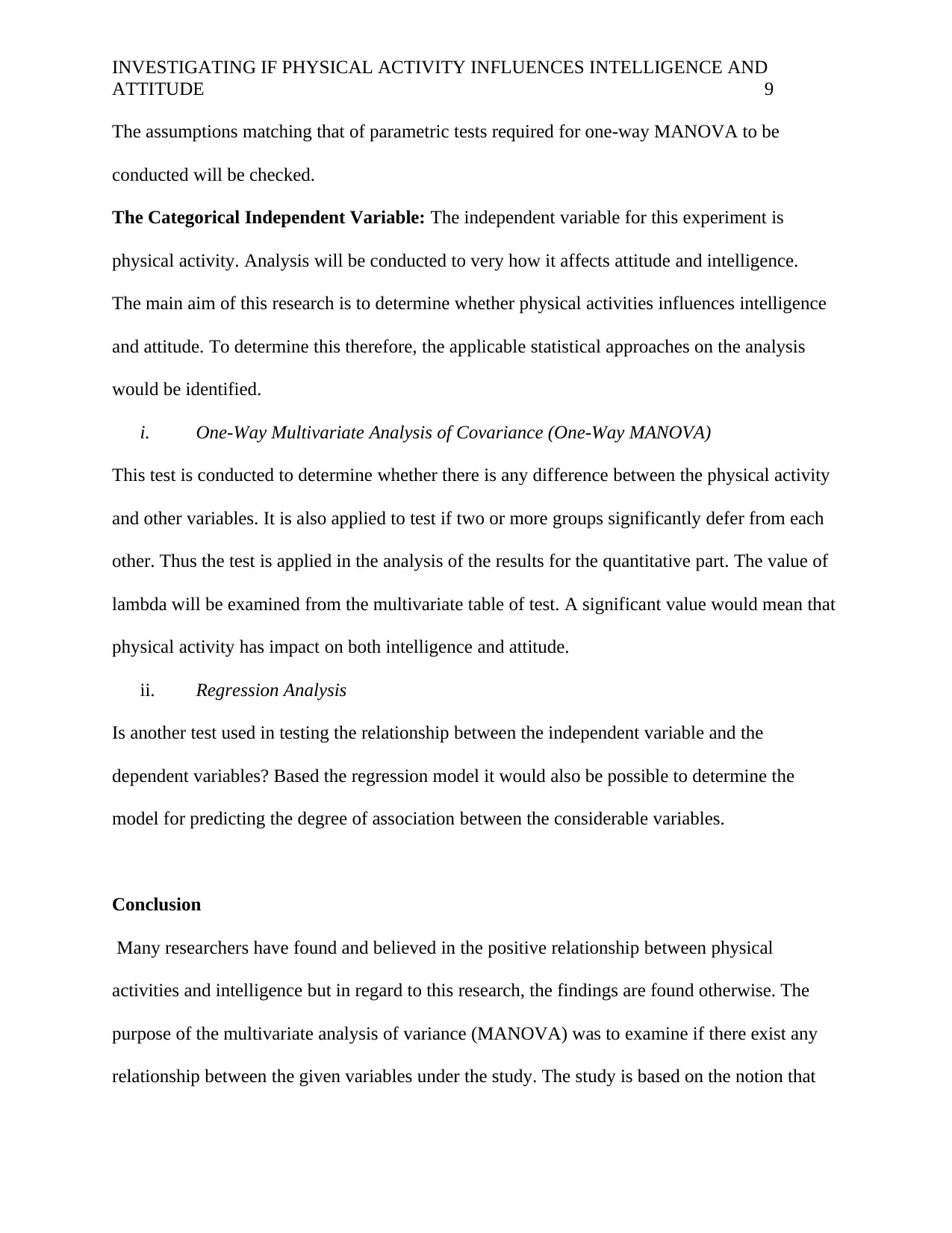
INVESTIGATING IF PHYSICAL ACTIVITY INFLUENCES INTELLIGENCE AND
ATTITUDE 9
The assumptions matching that of parametric tests required for one-way MANOVA to be
conducted will be checked.
The Categorical Independent Variable: The independent variable for this experiment is
physical activity. Analysis will be conducted to very how it affects attitude and intelligence.
The main aim of this research is to determine whether physical activities influences intelligence
and attitude. To determine this therefore, the applicable statistical approaches on the analysis
would be identified.
i. One-Way Multivariate Analysis of Covariance (One-Way MANOVA)
This test is conducted to determine whether there is any difference between the physical activity
and other variables. It is also applied to test if two or more groups significantly defer from each
other. Thus the test is applied in the analysis of the results for the quantitative part. The value of
lambda will be examined from the multivariate table of test. A significant value would mean that
physical activity has impact on both intelligence and attitude.
ii. Regression Analysis
Is another test used in testing the relationship between the independent variable and the
dependent variables? Based the regression model it would also be possible to determine the
model for predicting the degree of association between the considerable variables.
Conclusion
Many researchers have found and believed in the positive relationship between physical
activities and intelligence but in regard to this research, the findings are found otherwise. The
purpose of the multivariate analysis of variance (MANOVA) was to examine if there exist any
relationship between the given variables under the study. The study is based on the notion that
ATTITUDE 9
The assumptions matching that of parametric tests required for one-way MANOVA to be
conducted will be checked.
The Categorical Independent Variable: The independent variable for this experiment is
physical activity. Analysis will be conducted to very how it affects attitude and intelligence.
The main aim of this research is to determine whether physical activities influences intelligence
and attitude. To determine this therefore, the applicable statistical approaches on the analysis
would be identified.
i. One-Way Multivariate Analysis of Covariance (One-Way MANOVA)
This test is conducted to determine whether there is any difference between the physical activity
and other variables. It is also applied to test if two or more groups significantly defer from each
other. Thus the test is applied in the analysis of the results for the quantitative part. The value of
lambda will be examined from the multivariate table of test. A significant value would mean that
physical activity has impact on both intelligence and attitude.
ii. Regression Analysis
Is another test used in testing the relationship between the independent variable and the
dependent variables? Based the regression model it would also be possible to determine the
model for predicting the degree of association between the considerable variables.
Conclusion
Many researchers have found and believed in the positive relationship between physical
activities and intelligence but in regard to this research, the findings are found otherwise. The
purpose of the multivariate analysis of variance (MANOVA) was to examine if there exist any
relationship between the given variables under the study. The study is based on the notion that
⊘ This is a preview!⊘
Do you want full access?
Subscribe today to unlock all pages.

Trusted by 1+ million students worldwide
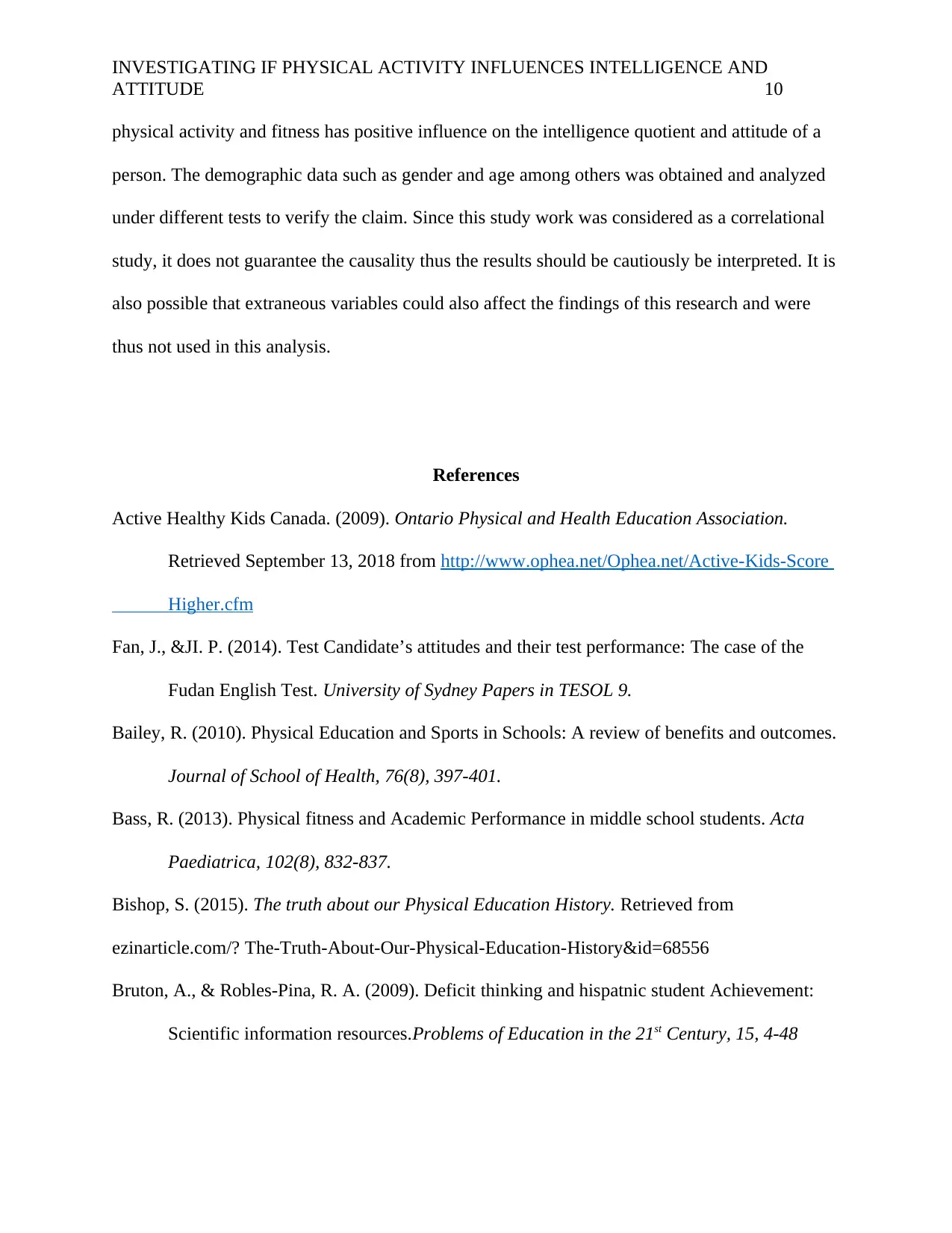
INVESTIGATING IF PHYSICAL ACTIVITY INFLUENCES INTELLIGENCE AND
ATTITUDE 10
physical activity and fitness has positive influence on the intelligence quotient and attitude of a
person. The demographic data such as gender and age among others was obtained and analyzed
under different tests to verify the claim. Since this study work was considered as a correlational
study, it does not guarantee the causality thus the results should be cautiously be interpreted. It is
also possible that extraneous variables could also affect the findings of this research and were
thus not used in this analysis.
References
Active Healthy Kids Canada. (2009). Ontario Physical and Health Education Association.
Retrieved September 13, 2018 from http://www.ophea.net/Ophea.net/Active-Kids-Score
Higher.cfm
Fan, J., &JI. P. (2014). Test Candidate’s attitudes and their test performance: The case of the
Fudan English Test. University of Sydney Papers in TESOL 9.
Bailey, R. (2010). Physical Education and Sports in Schools: A review of benefits and outcomes.
Journal of School of Health, 76(8), 397-401.
Bass, R. (2013). Physical fitness and Academic Performance in middle school students. Acta
Paediatrica, 102(8), 832-837.
Bishop, S. (2015). The truth about our Physical Education History. Retrieved from
ezinarticle.com/? The-Truth-About-Our-Physical-Education-History&id=68556
Bruton, A., & Robles-Pina, R. A. (2009). Deficit thinking and hispatnic student Achievement:
Scientific information resources.Problems of Education in the 21st Century, 15, 4-48
ATTITUDE 10
physical activity and fitness has positive influence on the intelligence quotient and attitude of a
person. The demographic data such as gender and age among others was obtained and analyzed
under different tests to verify the claim. Since this study work was considered as a correlational
study, it does not guarantee the causality thus the results should be cautiously be interpreted. It is
also possible that extraneous variables could also affect the findings of this research and were
thus not used in this analysis.
References
Active Healthy Kids Canada. (2009). Ontario Physical and Health Education Association.
Retrieved September 13, 2018 from http://www.ophea.net/Ophea.net/Active-Kids-Score
Higher.cfm
Fan, J., &JI. P. (2014). Test Candidate’s attitudes and their test performance: The case of the
Fudan English Test. University of Sydney Papers in TESOL 9.
Bailey, R. (2010). Physical Education and Sports in Schools: A review of benefits and outcomes.
Journal of School of Health, 76(8), 397-401.
Bass, R. (2013). Physical fitness and Academic Performance in middle school students. Acta
Paediatrica, 102(8), 832-837.
Bishop, S. (2015). The truth about our Physical Education History. Retrieved from
ezinarticle.com/? The-Truth-About-Our-Physical-Education-History&id=68556
Bruton, A., & Robles-Pina, R. A. (2009). Deficit thinking and hispatnic student Achievement:
Scientific information resources.Problems of Education in the 21st Century, 15, 4-48
Paraphrase This Document
Need a fresh take? Get an instant paraphrase of this document with our AI Paraphraser
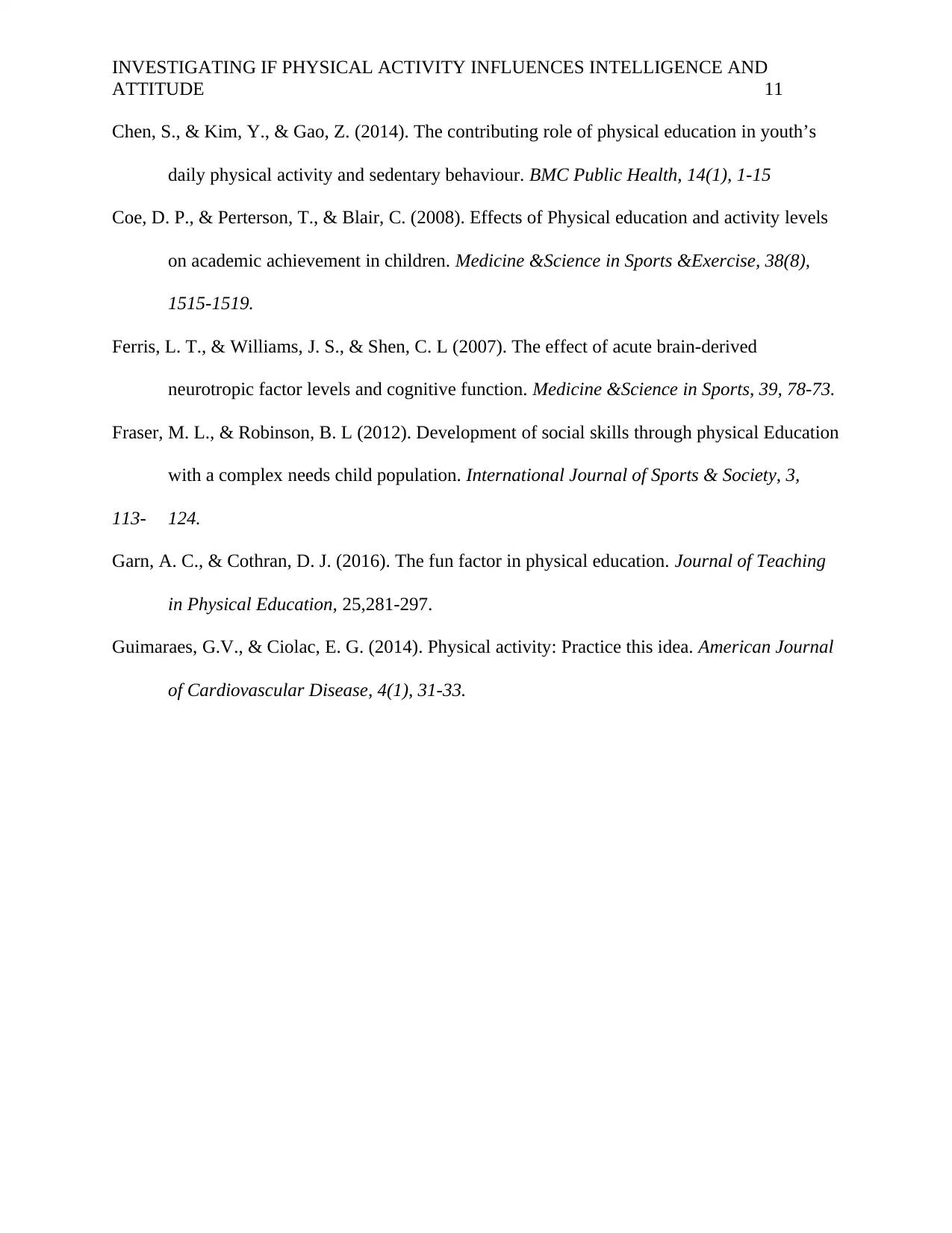
INVESTIGATING IF PHYSICAL ACTIVITY INFLUENCES INTELLIGENCE AND
ATTITUDE 11
Chen, S., & Kim, Y., & Gao, Z. (2014). The contributing role of physical education in youth’s
daily physical activity and sedentary behaviour. BMC Public Health, 14(1), 1-15
Coe, D. P., & Perterson, T., & Blair, C. (2008). Effects of Physical education and activity levels
on academic achievement in children. Medicine &Science in Sports &Exercise, 38(8),
1515-1519.
Ferris, L. T., & Williams, J. S., & Shen, C. L (2007). The effect of acute brain-derived
neurotropic factor levels and cognitive function. Medicine &Science in Sports, 39, 78-73.
Fraser, M. L., & Robinson, B. L (2012). Development of social skills through physical Education
with a complex needs child population. International Journal of Sports & Society, 3,
113- 124.
Garn, A. C., & Cothran, D. J. (2016). The fun factor in physical education. Journal of Teaching
in Physical Education, 25,281-297.
Guimaraes, G.V., & Ciolac, E. G. (2014). Physical activity: Practice this idea. American Journal
of Cardiovascular Disease, 4(1), 31-33.
ATTITUDE 11
Chen, S., & Kim, Y., & Gao, Z. (2014). The contributing role of physical education in youth’s
daily physical activity and sedentary behaviour. BMC Public Health, 14(1), 1-15
Coe, D. P., & Perterson, T., & Blair, C. (2008). Effects of Physical education and activity levels
on academic achievement in children. Medicine &Science in Sports &Exercise, 38(8),
1515-1519.
Ferris, L. T., & Williams, J. S., & Shen, C. L (2007). The effect of acute brain-derived
neurotropic factor levels and cognitive function. Medicine &Science in Sports, 39, 78-73.
Fraser, M. L., & Robinson, B. L (2012). Development of social skills through physical Education
with a complex needs child population. International Journal of Sports & Society, 3,
113- 124.
Garn, A. C., & Cothran, D. J. (2016). The fun factor in physical education. Journal of Teaching
in Physical Education, 25,281-297.
Guimaraes, G.V., & Ciolac, E. G. (2014). Physical activity: Practice this idea. American Journal
of Cardiovascular Disease, 4(1), 31-33.
1 out of 11
Your All-in-One AI-Powered Toolkit for Academic Success.
+13062052269
info@desklib.com
Available 24*7 on WhatsApp / Email
![[object Object]](/_next/static/media/star-bottom.7253800d.svg)
Unlock your academic potential
Copyright © 2020–2025 A2Z Services. All Rights Reserved. Developed and managed by ZUCOL.